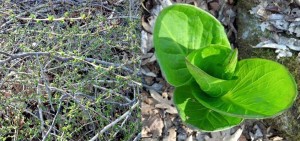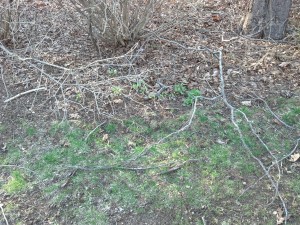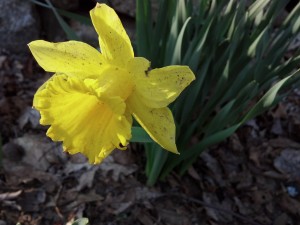Spring has come late this year. The grass has that yellow-green color and the daffodils starting to bloom. A few shoots of early perennials are coming up, but not much else. The trees aren’t budding yet, so the woods look brown. Early this week after a warm weekend, I was driving to work looking at the forest as I drove the back roads. Everything was still brown. All except for…
… pricker bushes and skunk cabbage.
Let me describe these “lovely” plants in case you don’t have them where you live. Pricker bushes are ugly, scraggly bushes that have no redeeming qualities, except to keep people or animals away from the area where they are growing. They have no beautiful shape, interesting leaves, or flowers of any kind. What they have in abundance is THORNS. They can carve up your skin in no time flat. They spread via underground roots, and are difficult to eradicate. Over the years we’ve tried mowing them down, spraying, and digging them up. They always come back.
Skunk cabbage (skunkus cabbagus) is a weed that grows near brooks. When the plant is young, the leaves look a bit like the outer leaves of a cabbage plant. The inner part is tight, like a ball, until it grows out. It grows about eighteen inches high. The plant is quite green, and not horribly unattractive or destructive. However, it smells faintly like skunk if you brush it when you walk by. When you pick it, it REEKS. It smells very much like skunk, hence its name. If the oil gets on you, look out. No one will want to be anywhere near you for a while. We used to use the plants as implements of torture when we were kids. We’d pick some, hold down a kid who had done something mean, and stick it under their nose until they cried “uncle”.
As you can imagine, these are not the most desirable plants. Most people do everything they can to get rid of them. And as I drove to work, these nasty plants appeared to be the only living things in the woods.
Seeing Them Everywhere
Once I saw them it seemed that they were everywhere. All I saw were dead leaves, the pricker bushes, and the skunk cabbage. It was as if my mind was looking for, and then finding them. I drove for a few more minutes, and then shifted my thinking. Rather than look for the prickers and skunk cabbage, I decided to just see what was there. Once I changed my focus, I began to see all kinds of other things, and the prickers and skunk cabbage faded into the background.
A Change of Perspective
Later this week, at home, I walked around my property. As I walked through the woods, I saw the prickers and skunk cabbage. After all, they are still one of the few things looking alive in the woods. I also saw tons of sticks,
the start of the peony tree blossoms, and a few buds on the rose bushes. And then I saw these
and these.
Beauty and blessing. All because I took the time to look.
What can you learn from this?
- What you focus on is what you see.
- You can shift your focus to see something other than the prickers and skunk cabbage in your life.
- Sometimes you have to look harder for the blessings. They are always there, but not always the first thing you see.
Question: What are your prickers and skunk cabbage? How could shifting your focus help you see the blessings in your life? Click here to leave a comment.






Kathleen, I try to think of skunk cabbage as a sign of spring and have learned to avoid it up close. As I’ve always said, and try to do, is keep my eye upon the doughnut and not upon the hole. Thanks for spreading your light and positivity. You have a lot in common with Norman Vincent Peale and Mary Baker Eddy. Thanks for being there!
Bob, I love that you keep your eye on the doughnut!
Latest spring update: There is a hint of pink coming from some azalea bushes.